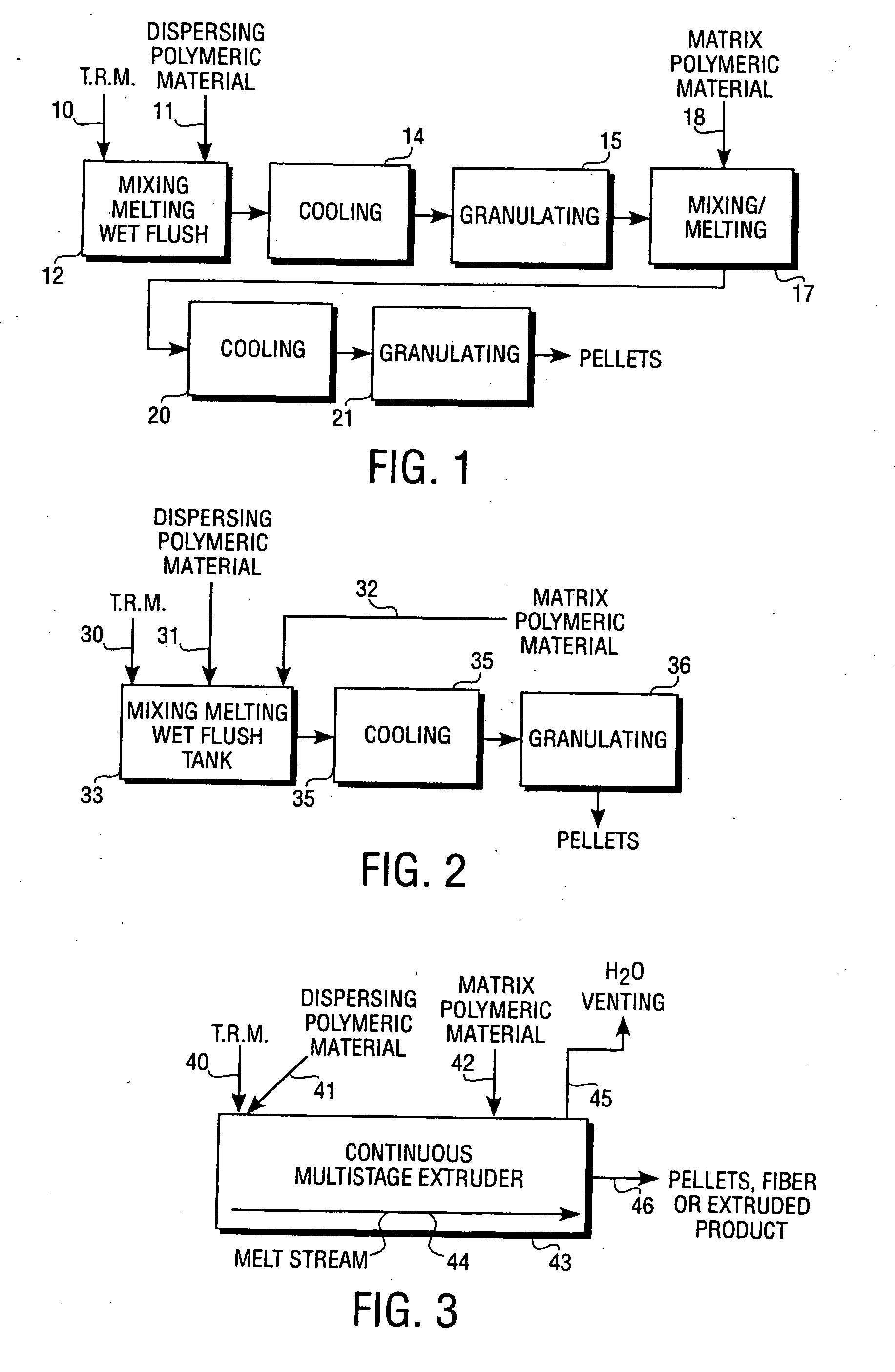Polymeric composites having enhanced reversible thermal properties and methods of forming thereof
a composite material and thermal insulation technology, applied in the field of polymeric composite materials, can solve the problems of poor fiber properties, insufficient dispersion of phase change materials within the fibers, and more difficult incorporation of phase change materials into melt spun synthetic fibers
- Summary
- Abstract
- Description
- Claims
- Application Information
AI Technical Summary
Problems solved by technology
Method used
Image
Examples
example 1
[0091] About 5.0 pounds of a low molecular weight polyethylene homopolymer (AC-16 polyethylene, drop point of 102° C., manufactured by Honeywell Specialty Chemical) was added to a wet flushing apparatus, and the homopolymer was then slowly melted and mixed at about 110° C. to about 130° C. Once the homopolymer was melted, about 8.47 pounds of a wet cake was slowly added to the molten homopolymer over about a 30 minute time period to form a first blend. The wet cake included water-wetted microcapsules containing a phase change material (micro PCM lot# M 42-31, 59.0 percent by weight of the microcapsules and the phase change material, manufactured by MicroTek Laboratories, Inc.).
[0092] Water was flashed off as the microcapsules containing the phase change material was added to and dispersed in the molten homopolymer. Mixing continued until less than about 0.15 percent by weight of the water remained (as measured using Karl-Fischer titration). The resulting first blend was then cooled...
example 2
[0097] Differential Scanning Calorimeter (DSC) measurements of the above synthetic fibers were made using a Perkin Elmer Pyris 1 instrument. Cooling was accomplished using a FTS Systems Intercoller 1. Data analysis was performed using a Perkin Elmer Pyris Thermal Analysis System and Software for Windows, version 3.72.
[0098] Test samples were prepared in Perkin Elmer hermetically sealed aluminum sample pans, and testing was performed while the test samples were continuously subjected to N2 flow.
[0099] Test conditions included: 1) cooling the test samples to about −10° C.; 2) isothermal hold for about 1 minute at −10° C.; 3) heating from −10° C. to about 50° C. at a rate of about 5° C. per minute; 4) isothermal hold for about 1 minute at 50° C.; and then 5) cooling from 50° C. to about −10° C. at a rate of about 5° C. per minute.
[0100] Using the DSC measurements as described above, the synthetic fibers provided between about 17.5 and 23.2 J / g of thermal energy storage capacity (i.e...
example 3
[0101] About 3.1307 grams of a phase change material in a raw form (Kenwax 19 paraffin, blend of C18 through C24 paraffinic hydrocarbons, 150 J / g latent heat) was placed in a vial, and about 3.1255 grams of a polymeric material (Elvax 450, 18 percent by weight of vinyl acetate, polyethylene-co-vinyl acetate polymer supplied by DuPont Inc.) having a slight or partial affinity for the phase change material was added to the vial. The phase change material and the polymeric material were mixed together at between 120° C. to 130° C. by hand to produce a 50:50 by weight blend that was homogeneous and clear. Upon cooling, a polymeric composite was formed, which polymeric composite was hazy and rubbery and without a waxy or greasy feel. A DSC measurement of the polymeric composite showed 73.3 J / g of thermal energy storage capacity, which corresponds to 48.9 percent of the Kenwax 19 available to provide a thermal regulating property.
[0102] A practitioner of ordinary skill in the art require...
PUM
| Property | Measurement | Unit |
|---|---|---|
| Temperature | aaaaa | aaaaa |
| Temperature | aaaaa | aaaaa |
| Temperature | aaaaa | aaaaa |
Abstract
Description
Claims
Application Information
 Login to View More
Login to View More - R&D
- Intellectual Property
- Life Sciences
- Materials
- Tech Scout
- Unparalleled Data Quality
- Higher Quality Content
- 60% Fewer Hallucinations
Browse by: Latest US Patents, China's latest patents, Technical Efficacy Thesaurus, Application Domain, Technology Topic, Popular Technical Reports.
© 2025 PatSnap. All rights reserved.Legal|Privacy policy|Modern Slavery Act Transparency Statement|Sitemap|About US| Contact US: help@patsnap.com

